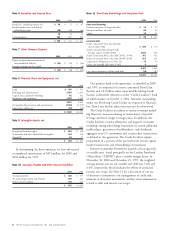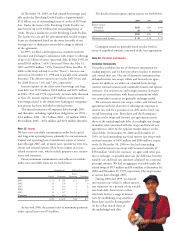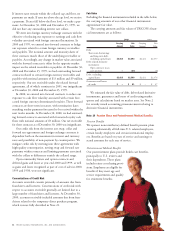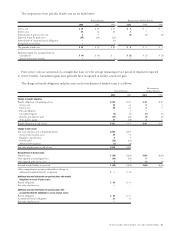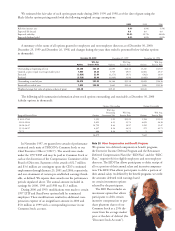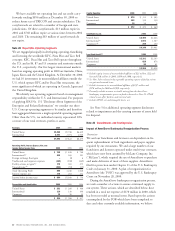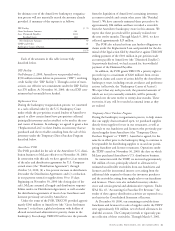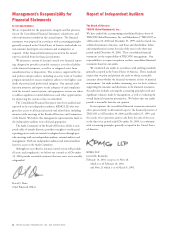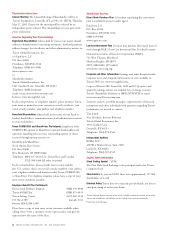Pizza Hut 2000 Annual Report Download - page 64
Download and view the complete annual report
Please find page 64 of the 2000 Pizza Hut annual report below. You can navigate through the pages in the report by either clicking on the pages listed below, or by using the keyword search tool below to find specific information within the annual report.
62 TRICON GLOBAL RESTAURANTS, INC. AND SUBSIDIARIES
we have collected approximately $43 million. On November
30, 2000, we sold our remaining inventories to McLane at an
amount approximating book value. We have no remaining
payables to suppliers under the TDPP.
Other
We have incurred and will continue to incur other incremental
costs (principally professional fees) as a result of the AmeriServe
bankruptcy reorganization process which are being charged as
incurred to unusual items. We expect that these costs, though
substantially reduced from pre-POR levels, will continue until
the affairs of the estate can be substantially concluded; however,
we do not expect that these costs, net of any recoveries from
the Bankruptcy Causes of Action, will be material to our
annual results of operations, financial condition or cash flows.
Other Commitments and Contingencies
Contingent Liabilities
We were directly or indirectly contingently liable in the
amounts of $401 million and $386 million at year-end 2000
and 1999, respectively, for certain lease assignments and
guarantees. At December 30, 2000, $333 million represented
contingent liabilities to lessors as a result of assigning our
interest in and obligations under real estate leases as a condi-
tion to the refranchising of Company restaurants and the
contribution of certain Company restaurants to a new venture
in Canada. The $333 million represented the present value of
the minimum payments of the assigned leases, excluding any
renewal option periods, discounted at our pre-tax cost of debt.
On a nominal basis, the contingent liability resulting from
the assigned leases was $513 million. The remaining amounts
of the contingent liabilities primarily relates to our guarantees
to support financial arrangements of certain unconsolidated
affiliates and franchisees. The contingent liabilities related to
financial arrangements of franchisees include partial guarantees
of franchisee loan pools originated primarily in connection
with the Company’s refranchising programs. In support of
these guarantees, we have posted $22 million of letters of
credit and $10 million in cash collateral. The cash collateral
balances are included in Other Assets. Also, TRICON pro-
vides a standby letter of credit under which TRICON could
potentially be required to fund a portion (up to $25 million)
of one of the franchisee loan pools discussed above. Any such
funding under the standby letter of credit would then be
fully secured by franchisee loan collateral. We have provided
for our estimated probable exposures under these contingent
liabilities largely through charges to refranchising gains (losses).
Casualty Loss Programs and Estimates
We are currently self-insured for a portion of our current and
prior years’ casualty losses, property losses and certain other
insurable risks. To mitigate the cost of our exposures for cer-
tain casualty losses, we make annual decisions to either retain
the risks of loss up to certain maximum per occurrence or
aggregate loss limits negotiated with our insurance carriers or
to fully insure those risks. Since the Spin-off, we have elected
to retain the risks subject to insured limitations. In addition,
we also purchased insurance in 1998 to limit the cost for
certain of our retained risks for the years 1994 to 1996.
Effective August 16, 1999, we made changes to our U.S.
and portions of our International property and casualty loss
programs. For fiscal year 2000 and the period from August 16,
1999 through fiscal year end, 1999, we bundled our risks for
casualty losses, property losses and various other insurable
risks into one risk pool with a single maximum loss limit.
Certain losses in excess of the single maximum loss limit
are covered under reinsurance agreements. Since all of these
risks have been pooled and there are no per occurrence limits
for individual claims, it is possible that we may experience
increased volatility in property and casualty losses on a quarter
to quarter basis. This would occur if an individual large loss
is incurred either early in a program year or when the latest
actuarial projection of losses for a program year is significantly
below our aggregate loss retention. A large loss is defined as
a loss in excess of $2 million which was our predominant
per occurrence casualty loss limit under our previous insur-
ance program.
We have accounted for our retained liabilities for casualty
losses, including reported and incurred but not reported
claims, based on information provided by our independent
actuary. Effective August 16, 1999, property losses are also
included in our actuary’s valuation. Prior to that date, prop-
erty losses were based on our internal estimates.
Actuarial valuations are performed and resulting adjust-
ments to current and prior years’ self-insured casualty losses,
property losses and other insurable risks, are made in the sec-
ond and fourth quarters of each fiscal year. The adjustments
recorded to our casualty loss reserves in 2000 were insignificant.
We recorded favorable adjustments of $30 million in 1999
and $23 million in 1998. The 1999 and 1998 adjustments
resulted primarily from improved loss trends related to 1998
casualty losses at all three of our U.S. Concepts. In addition,
the favorable insurance adjustments in 1998 included the
benefit of the insurance transaction to limit the cost for
certain of our retained risk for the years 1994 to 1996.
We will continue to make adjustments both based on our
actuary’s periodic valuations as well
as whenever there are significant
changes in the expected costs of
settling large claims that have
occurred since the last actuarial
valuation was performed.


